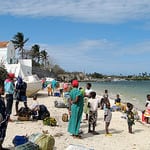Will hotel development spell the downfall of Quirimbas Archipelago?

Skift Take
The challenge of delivering a consistent experience for visitors is on factor that leads to distinctive destinations like the Quirimbas to transform to suit outsiders. How this remote location meets the challenge will determine its future.
We needed to calm down, and the remedy lay in Paolo's plane revving up in front of us. Once aboard the Cessna Caravan, we soon relaxed as we flew south above the wild, tropical Indian Ocean coast, spilling its shallows and sandbars into the emerald, translucent sea. Next came the almost unbroken chain of just-offshore coral islands (32 in all): islets, reefs, baixos (sunken islands) and tiny shards of white-hot sand that make up the little-known, untrammelled Quirimbas Archipelago.
Seen from 4,000ft, the shapes and colours were mesmerising. Knots of land, thick with mangroves, ringed by white sand, spread their coral skirts beneath water so clear that you can almost see the turtles, Napoleon wrasse, morays, puffer fish, nudibranchs and bumphead parrotfish that help to make the Quirimbas one of the world's top diving destinations. But if you can't quite see the fish from the sky, you can certainly see the fishermen, poised like herons with their nets and hand lines, scattered across these vast shallow coral reefs, working by day and returning to their villages on the mainland, or camping on the islands by night. Sprinkled across the sun-splattered water are their dugouts and pointed dhows, each with a billowing makeshift sail. Their sight is a reminder of the story of the Quirimbas, occupied by Arabs from the 10th century, later controlled by the Portuguese, from whom Mozambique gained independence in 1975. Some of the islands are permanently inhabited; others are simply bases for fishermen. Most are simple in the extreme, a few have a natural water supply, and some are beginning to offer places to stay, as are places on the mai
